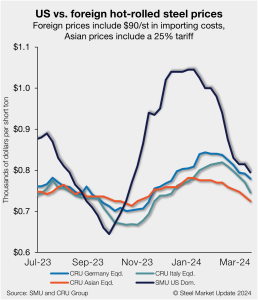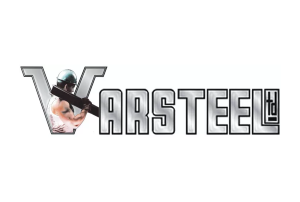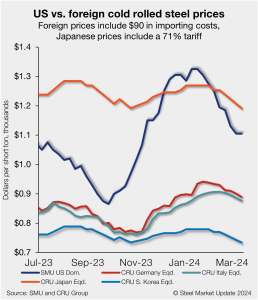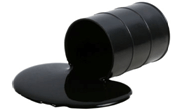Miller on scrap: Market deals with ferrous scrap dive
As the month of March goes into the second half, the scrap community is trying to cope with the large drop in ferrous scrap earlier this month.
As the month of March goes into the second half, the scrap community is trying to cope with the large drop in ferrous scrap earlier this month.
With Earth Day almost a month away, the world’s attention often turns to the manufacturing sector with calls for greener production processes.
I’ve had questions from some of you lately about how we should think of the spread between hot-rolled (HR) coil prices and those for cold-rolled (CR) and coated product. Let’s assume that mills are intent on holding the line at least at $800 per short ton (st) for HR. The norm for HR-CR/coated spreads had been about $200 per short ton (st). That would suggest CR and coated base prices should be ~$1,000/st. Good luck finding anyone offering that.
Worthington Steel’s profits jumped in its fiscal third quarter of 2024 vs. a year earlier, its first quarter as a standalone company.
A temporary surplus of rebar on the West Coast is forcing CMC to alter the planned ramp-up of its Arizona 2 micro-mill, the company's leader said on Thursday.

US hot-rolled coil (HRC) remains more expensive than offshore hot band but continues to move closer to parity as prices decline further. The premium domestic product had over imports for roughly five months now remains near parity as tags abroad and stateside inch down.
SMU caught up with Barry Zekelman, executive chairman and CEO of Zekelman Industries, on Wednesday’s Community Chat. As one of the largest independent steel pipe and tube manufacturers in North America, his company is also one of the largest steel buyers in the region. This year alone, the Chicago-based company will buy roughly 2.8 million tons of steel. As such, Zekelman provides a great perspective on the steel industry and the markets it serves.
CMC’s earnings slid in its fiscal second quarter vs. the same period last year as the company cited seasonal issues and challenging weather conditions in several key areas.

Varsteel, a Canadian steel and pipe service center, has announced the acquisition of Pacific Steel in Laval, Quebec.

Earlier this week SMU polled steel buyers on an array of topics, ranging from market prices, demand, and inventories to imports and evolving market chatter.
Nucor has signed an agreement with Mercedes-Benz to supply the low-carbon steel Econiq-RE at the automaker’s Tuscaloosa, Ala., plant.
SMU’s price for hot-rolled (HR) inched lower this week. I wouldn’t be surprised, however, if we start to see prices and lead times move higher in the weeks ahead. The modest declines in HR this week are probably the result of lingering deals cut at “old” prices, as sometimes happens after mill price increases. But those deals will probably be out of the market soon if they aren’t already. So why do I float the idea of higher prices? Some big buys have been placed. It reminds me a little of what we saw last fall, when people restocked in anticipation of higher prices once the UAW strike was resolved.

Across industries and nations, it’s clear sustainability is the path towards the future. Moving ahead means creating dialogue and building bridges. For Nucor, building bridges means reaching out to new audiences. Actually, it also literally means soon building bridges from the plate made at its Brandenburg mill in Kentucky.
As uncertainty swirls around Nippon Steel Corp.’s (NSC) proposed buy of U.S. Steel, the Japanese steelmaker continues to make assurances that it has the best interests in mind for running the iconic Pittsburgh-based steelmaker.

Data on US industrial production, capacity utilization, new orders, and inventories remained overall steady and strong through January and February figures, indicating a healthy manufacturing sector. The strength of the manufacturing economy has a direct bearing on the health of the steel industry.
Radius Recycling anticipates a wider loss in its fiscal second quarter vs. the first quarter, according to preliminary results.
Domestic production of raw steel moved lower last week, slipping back down after recovering the week prior, according to the most recent data from the American Iron and Steel Institute (AISI).
U.S. Steel expects higher earnings in the first quarter of this year vs. the previous quarter.
Are we still looking for a bottom on sheet prices? In what direction are steel and scrap prices headed? How’s demand holding up at the moment?

Happy St. Patrick’s Day. “To govern is to choose.” Those words, reportedly first uttered by the late French Premier Pierre Mendes-France in the 1950s, resonate vividly in our time. It means that choices have consequences and that priorities must be set based on goals. Interested parties, in and out of government, raise their voices in […]

The spot rate trend in the flatbeds has seen a positive upturn. There are potential rate accelerators and decelerators, however, likely to influence spot and contract flatbed rates. The flatbed market for spot rates is showing signs of improvement as we move through the new year. February increased slightly from January, marking the third consecutive […]

Foreign cold-rolled coil (CR) remains significantly less expensive than domestic product even as US tags continue to decline in a hurry, according to SMU’s latest check of the market.

Rig counts in the US and Canada were mixed this week, according to the latest data from Baker Hughes.
The CRUspi fell by 8.3% month over month (m/m) in March to 206.6 as weaker-than-expected demand weighed on markets around the world. Price falls were notable across all regions, with elevated inventory levels pushing prices in the US and Europe, and disappointing stimulus measures from the Chinese government weighing on those in Asia.
In this Premium analysis we cover North American oil and natural gas prices, drilling rig activity, and crude oil stock levels.
Steel Market Update’s Steel Demand Index recovered out of contraction territory on the heels of the pricing blitz from mills last week, according to our latest survey data.
Flat Rolled = 56.6 Shipping Days of Supply Plate = 58.8 Shipping Days of Supply Flat Rolled After weaker-than-expected shipments in January, US service center shipments of flat-rolled steel picked up in February, which caused supply to decrease. At the end of February, service centers carried 56.6 shipping days of flat-rolled steel supply on an […]

SMU’s Current Steel Buyers’ Sentiment Index edged down while the Future Sentiment Index ticked up, according to our most recent survey data
Strength in its flat-rolled steel operations is pushing Steel Dynamics Inc. (SDI) to guide to higher sequential earnings in the current quarter.
Nippon Steel has reaffirmed the value of its deal for U.S. Steel a day after President Biden issued a statement opposing the sale.